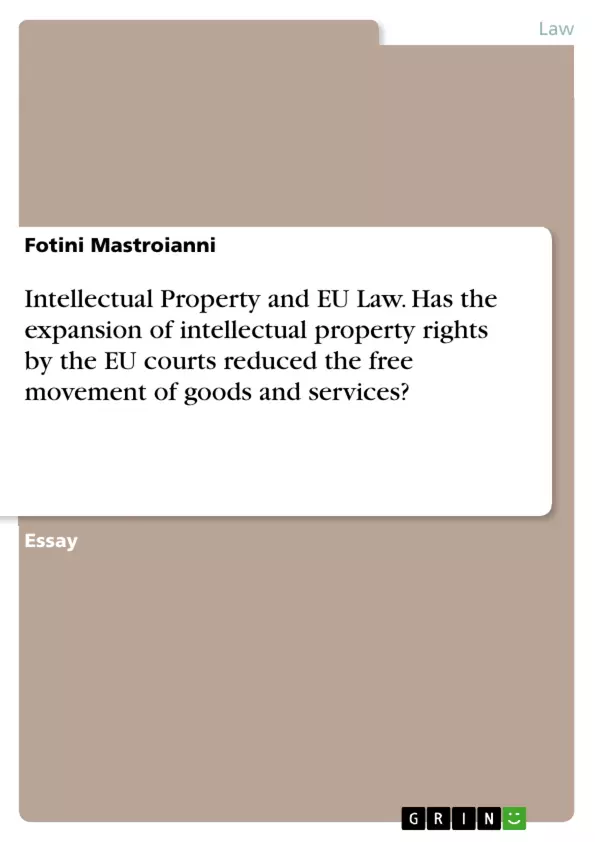In the present essay, intellectual property and free movement of goods and services will be discussed and it will be examined how and to what extent the intellectual property right law affects or does not affect free movement of goods and services.
Intellectual property law is a branch of private law and regulates the protection of an object with intangible nature. The distinction between an intangible asset and the material carrier is known and runs around the law of intellectual property. The album as a physical body is a corporeal object is outside the field of intellectual property, as opposed to composing music recorded over it. The same applies for the printed versions. Intellectual property does not protect the material itself but the scientific work that is reflected on it.
A fundamental principle of the intellectual property right law is the protection of independence of the value and purpose of the project. This work is protected regardless of its illegal or immoral character. This rule is now expressly enshrined in Article 2 § 4 of the Act and applies to all projects.
On the other hand, the free movement of goods is the first in the order listed in the Treaty of the four fundamental freedoms of the EU and is regulated by Articles 28-37 TFEU as Title II of its Part Three ("Internal policies and action Union ").
From these articles, the first two, namely Articles 28 and 29, seem to have introductory nature and general scope of implementation, while the remaining eight are divided into three chapters as follows: Chapter 1, Articles 30-32, "The customs union" Chapter 2, Article 33,"customs cooperation", Chapter 3, Articles 34-37," The prohibition of quantitative restrictions among Member States ".
Article 28 states that the Union shall comprise a "customs union" and defined the meaning of the latter (section 1), furthermore, it is bounded the substantive scope of implementing the critical for the free movement provisions which are the prohibition of customs duties and equivalent taxes provision of Article 30 and all the provisions of Chapter 3, i.e. it is bounded the cycle of products that fall under these provisions (section 2) and Article 29 focuses on the latter issue, but especially for products from third countries.
Inhaltsverzeichnis (Table of Contents)
- Introduction
- Intellectual Property
- Free movement of goods and services
- European Regulations on free movement of goods and intellectual property
- Cases
- Conclusion
Zielsetzung und Themenschwerpunkte (Objectives and Key Themes)
This essay delves into the intersection of intellectual property law and the free movement of goods and services within the European Union. The primary objective is to examine how intellectual property law affects the free movement of goods and services, analyzing the potential conflicts and tensions arising from these two fundamental pillars of the EU's legal framework.
- The nature of intellectual property rights and their impact on economic development
- The tension between intellectual property protection and the free movement of goods and services
- The role of technological advancements in the context of intellectual property rights and their implications for market access
- The evolving legal framework of the EU regarding intellectual property and its implications for trade
- The challenges and opportunities presented by the digital age for both intellectual property protection and the free movement of goods and services.
Zusammenfassung der Kapitel (Chapter Summaries)
- Introduction: This chapter provides an overview of the concepts of intellectual property and the free movement of goods, outlining their legal foundations and key principles within the EU framework. It highlights the importance of both concepts for economic growth and development.
- Intellectual Property: This chapter focuses on the nature of intellectual property rights and their economic impact. It discusses the balance between providing incentives for innovation and fostering competition through market access. It explores the role of technological advancements in the context of intellectual property protection, examining the challenges they pose and the potential solutions.
- Free movement of goods and services: This chapter outlines the legal framework for the free movement of goods and services within the EU. It examines the core principles of this fundamental freedom, including the prohibition of customs duties and quantitative restrictions. The chapter also explores the interplay between the free movement of goods and services and the need for intellectual property protection.
- European Regulations on free movement of goods and intellectual property: This chapter analyzes the specific European regulations that govern the relationship between the free movement of goods and intellectual property. It examines the legal framework for the protection of intellectual property rights in the context of cross-border trade and the potential for conflicts between these regulations.
- Cases: This chapter delves into specific case studies illustrating the practical application of EU law in the context of intellectual property and the free movement of goods and services. It analyzes key legal precedents and their impact on the interpretation and application of relevant regulations.
Schlüsselwörter (Keywords)
The main keywords and focus topics of this essay are: intellectual property rights, free movement of goods and services, European Union, trade law, legal framework, digital economy, technological protection, copyright, market access, competition, innovation, and case studies.
- Quote paper
- Fotini Mastroianni (Author), 2013, Intellectual Property and EU Law. Has the expansion of intellectual property rights by the EU courts reduced the free movement of goods and services?, Munich, GRIN Verlag, https://www.grin.com/document/352466



